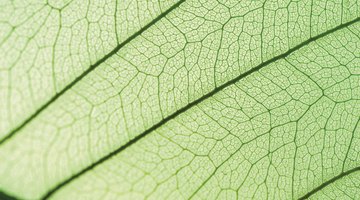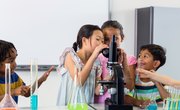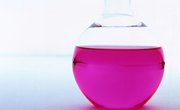The complex chemical processes involved in photosynthesis can keep college students up all night studying for botany exams. Lucky for fifth-graders, the National Next Generation Science Standards do not include details of the chemical reaction for photosynthesis at this time. The main concepts fifth-graders should understand are: energy is needed to change things, energy released from food once was energy captured from the sun by plants, and plants acquire what they need to grow from air and water in reactions powered by the sun.
Energy Changes Things
Students by the fifth grade may or may not have learned about chemical changes. If not, don't worry. The basic goal is to recognize that energy can cause change. Strike a match and watch it burn or put a radiometer in a sunny spot and watch it spin. Slowly pour egg whites into a beaker of boiling water and watch the clear, slippery liquid become a white solid; it changes. Ask students, “What was the energy needed to make that change?” After seeing many examples of how energy is necessary for any change, students will see that plants making their own food is just one of many amazing chemical changes going on around us every day.
Tracing it Back to Plants

All food we eat, from the burger to the bun, can be traced back to plants. Since plants get energy from the sun to build the molecules they are made of, all energy we have originated from the sun's energy. Help students grasp this concept by making simple food chains that can be displayed in the classroom. On blue index cards, write a popular food product. On white index cards, write each intermediate step -- with the name of the plant written in green. Finish with "Sun" on the final, yellow index card. Have students draw simple pictures of each on the card. Attach the cards with red arrows and display in your room. For example, Sun-->>Corn-->>Chicken; Sun-->>Wheat-->>Bread; Sun-->>Rice.
Photosynthesis Play: Act One
Buy five large T-shirts from a craft store which will serve as costumes for student actors in the photosynthesis play. Write "Sun" on the yellow shirt, "Water" on the blue shirt, "Carbon Dioxide" on the black shirt, "Oxygen" on the white shirt and "Sugar" on the green shirt. Draw a plant on the front of a large cardboard box. This will act as a photosynthesis machine. Turn the box so the open side faces away from the class. Stand behind the box. The student acting as Water will place blue paper circles into the box, and the student playing Carbon Dioxide will deposit black squares in the box. A narrator describes where the materials are obtained -- water from rain and carbon dioxide from air -- and continues explaining the process throughout the play.
Photosynthesis Play: Act 2
Your hands are hidden in the back of the box. When the student in yellow playing the Sun shines a flashlight on the box, you toss the products you have hidden inside -- oxygen and sugar-- out the other side of the box. Oxygen can be represented by white squares and sugar by small green triangles. The student playing Sugar picks up the green papers and the student playing Oxygen picks up the white papers and both place them into their own clear containers. The process keeps going as long as the carbon dioxide and water are being put into the side of the box and the flashlight sun is shining. In groups, glue pieces of green "sugar" paper pieces into the shape of a plant to demonstrate that plants are made of materials built in photosynthesis. Students then make a diagram to summarize the process of photosynthesis as demonstrated in the play.
Related Articles
References
Resources
Writer Bio
With degrees in biology and education, Jennifer VanBuren now utilizes her research and instructional skills as a writer. She has served as educational columnist for "Austin Family Magazine" for four years and also reports on area businesses for "Faces and Places" magazine.











